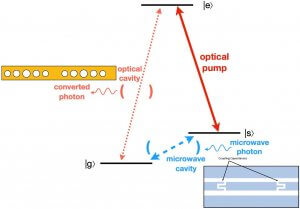Summary
In this project we develop a quantum interface between microwave and optical photons as a key enabling technology of a hybrid quantum network. In such a network, the robust optical photons carry quantum information through optical fibres over long distances, while superconducting microwave circuits protected from thermal photon noise by the low temperature environment of a dilution refrigerator function as quantum nodes, providing memory, processing and routing capability. Our work includes developing an integrated, microfabricated device that interfaces the fragile microwave photons and with optical photons through either individual or ensembles of three-level solid-state quantum emitters, such as nitrogen vacancy (NV) centers in diamonds. In addition, we are developing novel quantum memory and repeater designs. Here the device itself could serve as an optical quantum memory, storing information in the ground states where we may perform quantum control via a microwave circuit. It could also serve as a specialized quantum node. Entangling operations between remote superconducting circuits can be performed for repeater operation. Finally, we will also develop an efficient microwave photon detector that works by converting microwave photons into optical photons, which can then be efficiently detected with existing technology.

Figure 1. Microwave to optical conversion with a three level quantum emitter coupled to a microwave stripline cavity and an optical, e.g. a photonic-crystal, cavity: A microwave photon couples the two ground states |g> and |s> of a three-level quantum emitter with the help of the microwave cavity. The conversion is then completed through an optical pump and an enhanced emission into optical cavity coupled to the transition between the excited state |e> and the ground state |g>.
Related Content

Spin Generation and High-Frequency Detection via the Quantum Nonlinear Anomalous Hall Effect in Weyl Semimetals
In magnetic conductors, the passage of current yields an electric field in the transverse direction even without an external magnetic field – this is known as the anomalous Hall effect (AHE). This effect can act as a convenient probe of spin ordering, magnetic textures, spin-orbit coupling, and band topology in solids, and can be further […]
April 19, 2023

Materials for Majorana-based Topological Qubits
Summary Topological qubits offer a novel pathway to scalable quantum computing by simultaneously allowing for ease of coupling between qubits and strong decoupling of qubits from noise and dissipation. The most promising direction explores the topologically induced protection of theoretically predicted exotic quasiparticles, the so-called Majorana Zero Modes or MZMs. To-date MZMs, which follow […]
January 28, 2019

Portable Quantum Dot Measurement System
Summary Detecting heavy metals in water is essential to ensure clean drinking water and appropriate regulatory decisions following an accident (e.g., a spill) or an emergency. Traditionally, high-sensitivity detection of heavy metals requires bulky and costly (to purchase and operate) lab-based instruments. We propose developing a palm-sized, element-specific, highly-sensitive, battery-operated, smartphone-controlled system for on-site measurement […]
July 21, 2022

Engineering and Characterizing Programmable Interaction Graphs in a Trapped Ion Quantum Simulator
Summary Quantum simulators have the potential to bring unprecedented capabilities in areas such as the discovery of new materials and drugs. Engineering precise and programmable interaction graphs between qubits or spins forms the backbone of simulator applications. The trapped ion system is unique in that the interaction graph between qubits can be programmed, in […]
July 24, 2018

